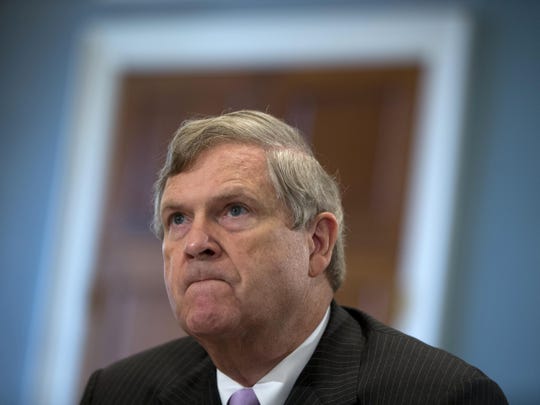
New records, covering 2018, show Vilsack — who joined the farmer-funded group on Feb. 1, 2017, after leaving President Barack Obama’s administration — was paid $999,421 in his first full year on the job.
He is executive vice president of the group and serves as president and CEO of the U.S. Dairy Export Council, a Dairy Management subsidiary.
Dairy Management, a nonprofit charged with promoting milk and other dairy products, came under fire over the summer after a Milwaukee Journal Sentinel report about salaries and spending at the Rosemont, Illinois-based organization.
In 2017, a year in which 503 dairy farms closed in Wisconsin and 1,600 were shuttered nationwide, IRS records showed the top 10 executives at the organization were paid more than $8 million — an average of more than $800,000 each, the Journal Sentinel found.
Last year, new records show, Vilsack’s salary and bonus/incentive compensation alone was $930,090, more than quadruple the $200,000 salary he received as a member of the Obama cabinet.
Dairy farmers, many of whom are struggling amid a downturn in milk prices, are required by Congress to pay into a checkoff program overseen by the Department of Agriculture. All told, there are about two dozen such programs, covering everything from avocado and Christmas tree farmers to cattle ranchers and pork producers.
The idea is that by banding together, farmers — including many small, family-run operations — will get more for their marketing buck.
“The fact remains that they are grossly overpaid considering the (lack of) success dairy farmers are seeing in the marketplace,” said Joe Maxwell, former executive director of the Organization for Competitive Markets and an outspoken critic of mandatory checkoff programs. “Perhaps they should let their executives go and bring on a team that could actually help the the dairy farmers of America.”
Farms must pay into the program even if they are operating at a loss — and dairy farmers pay a larger share than do other types of farmers.
Last year, the programs collected a combined $895 million to promote the various commodities. Of that, more than $420 million — 47% — came from dairy producers.
Dairy farmers must pay 15 cents per hundred pounds of milk sold into the checkoff program. Ten cents goes to state and regional marketing programs, such as the Dairy Farmers of Wisconsin. A nickel goes to national programs, such as Dairy Management.
All told, Dairy Management received $159.7 million from the checkoff program last year, up from $155 million in 2017, the new records show. .
The Journal Sentinel investigation found top Dairy Management officials were paid more than their counterparts in other farm-related programs — and more than in similar-sized nonprofits in general.
As agriculture secretary, Vilsack’s duties included overseeing the checkoff programs. He is one of the six Dairy Management executives who were paid more than $500,000 last year.
Two bipartisan bills aimed at reforming the checkoff programs are pending in Congress. One calls for making checkoff payments voluntary. A second would require groups receiving checkoff money to provide more transparency in their financial dealings.
Thomas Gallagher, Dairy Management’s chief executive since the group was incorporated in 1995, was paid $875,897 last year, down slightly from $899,810 in 2017. Gallagher’s pay has exceeded $1 million three times since 2013, records show.
Executive pay includes salary, bonuses, retirement, deferred compensation and other taxable and non-taxable compensation.
The records filed with the IRS note that the Dairy Management board can authorize first-class travel for Gallagher and that he and other top executives can receive health club benefits.
The top nine Dairy Management executives were paid $5.6 million last year — or an average of more than $617,000 each. That’s down a bit from 2017, in part because two executives, including one who retired mid-year, were paid more than $1 million each in 2017.
Heather Oldani, a Dairy Management spokeswoman, said in an email the group’s “salaries are within competitive levels of compensation for comparable positions.”
Requests to interview Vilsack and Gallagher were denied by Oldani.
The records also showed that in 2018 Dairy Management paid Daniel J. Edelman Inc., the nation’s largest public relations firm, $16.3 million for “agency services.”
It also paid Domino’s National Advertising Fund Inc. $9.1 million, Fairlife LLC $8 million and more than $5 million each to NFL Properties Inc. and McDonald’s USA LLC. Each of those payments were for “promotion,” according to the documents.
“Each year, we work with a number of partners to promote and build demand for and trust in dairy,” Oldani wrote in her email. “This includes working with a national PR and marketing agency like Edelman as well as foods service partners like Domino’s and McDonald’s.”
Oldani wrote that since 2015 the “partnerships have resulted in the additional sales of 1.2 billion pounds of dairy” products.
Maxwell, the checkoff critic, said dairy farmers should not have to pay successful national companies to use milk and dairy products.
“Those companies are doing very well .. yet dairy producers are subsidizing their research and development,” Maxwell said. “We have not seen a bump in the profits of dairy farmers because McDonald’s and Domino’s created menu items that use cheese.”
Andrew Mollica of the Journal Sentinel contributed to this story























